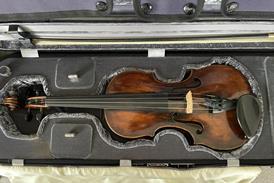The study suggests that orchestras could potentially play together under certain conditions

Scientists at the Charité in Berlin have issued a 13-page paper, at the request of seven Berlin orchestras, advising the distances to be observed in rehearsal and performance for the forseeable future, and suggesting that orchestras might be able to meet again under the following conditions:
Recommendations for orchestral arrangement depending on the group of instruments:
- String spacing 1.5 m.
- Blower stool spacing 2 m, liquid removal and instrument cleaning with disposable wipes (to be disposed of) or wipes (to be cleaned). Brass with additional plexiglass protection.
- Drummers with a chair spacing of 1.5 m, avoid sharing instruments and accessories.
- Harps and keyboard instruments 1.5 m apart.
- Conductor distance from the orchestral musicians at least 2 m for rehearsal and 1.5 m for concert.
General protective measures:
- Symptom mindfulness: Daily self-examination of clinical signs indicative of COVID-19: fever, cough, runny nose, sore throat, shortness of breath, head and body aches, gastrointestinal complaints, weakness, odor / taste disturbance. If one or more of these signs appear, the musician remains at home and should contact a doctor for a test for SARS-CoV-2.
- The employer offers employees of the high-risk groups for COVID-19 infections (see definitions of the Robert Koch Institute) an exemption within the framework of occupational health care. If desired, they can take part in the game.
- Observe hand hygiene and coughing labels, hand disinfection at least when entering and leaving the workplace.
- Physical distance of at least 1.5 m in general dealings with employees. Mouthguards should be worn in closed rooms outside the concert hall, this is no longer required on the podium.
- Normal cleaning of work rooms and functional rooms including changing rooms and toilets.
- Operation of air conditioning systems with an appropriate DIN standard, alternatively regular ventilation.
- Read: How are string soloists coping with the coronavirus lockdown?
- Read: Lawrence Power: life lessons from lockdown
The statement emphasises that further epidemiological developments and new research results must be taken into account during implementation. It also stresses that security measures for audiences must be worked out separately.
Prof. Stefan Willich, Director of the Institute for Social Medicine, Epidemiology and Health Economics at the Charité said: ’This statement creates an important basis for rehearsals and concerts for the orchestra. However, the game should initially be carried out in compliance with clear protective measures, including 1.5 meters for strings and 2 meters for wind players.’
The recommendations were provided at the request of the Berlin Philharmonic, DSO, Konzerthaus Orchestra, Orchestra of the German Opera and Komische Oper, Radio Symphony Orchestra and Berlin Staatskapelle.











































No comments yet